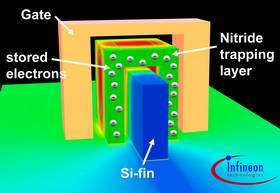Scientists at Infineon Technologies Build the World's Smallest Non-Volatile Flash Memory Cell

In a research breakthrough that has broken records in the semiconductor industry, scientists at Infineon Technologies AG have built the world’s smallest non-volatile flash memory cell. The new memory cell is measuring a mere 20 nanometers – approximately 5,000 times thinner than a human hair. Given that all manufacturing-related challenges - including that of the lithography - can be resolved, the new development would make nonvolatile memory chips with a capacity of 32 Gbit possible within a few years. That is eight times the capacity of what is currently available on the market.
Nonvolatile flash memories are becoming increasingly popular as mass storage media for devices such as digital cameras, camcorders and USB sticks. The most advanced nonvolatile flash memory devices available today can permanently store one or two bits of information per memory cell without a supply voltage. Such memories have a feature size of around 90 nanometers, and shrinking this feature size using typical techniques to half that size has posed many problems because of nanoscale physical effects. In particular, fabricating 20 nanometer-sized flash memory cells has been considered well nigh impossible because these physical effects would make the memory cells extremely unreliable.
The Infineon researchers overcame this challenge by creating a unique three-dimensional structure with a fin for the transistor that acts as the heart of the memory cell. The special geometry minimizes unwanted effects and significantly improves electrostatic control compared to today’s flat transistors. Called a FinFET (Fin Field Effect Transistor), the Infineon device stores the electrons which carry the information in a nitride layer that lies electrically isolated between the silicon fin and the gate electrode. Just 8 nanometers thin, the fin is controlled by the 20 nanometer-wide gate electrode.
The FinFET is also extremely durable and possesses excellent electrical characteristics. For example, the most advanced memories on the market today need approximately 1,000 electrons in order to reliably remember one bit. The new Infineon memory cell uses just 100 electrons; an additional 100 electrons stores a second bit in the same transistor. For comparison’s sake, 100 electrons roughly correspond to the number of electrons in a single gold atom. Despite these minimal charge levels, the sample of Infineon’s Munich laboratories showed excellent electrical characteristics.
Details about the new flash memory were presented at a post-deadline paper at the IEEE’s International Electron Devices Meeting in San Francisco yesterday.
















